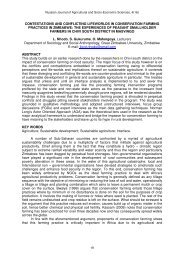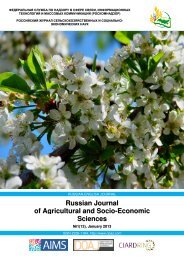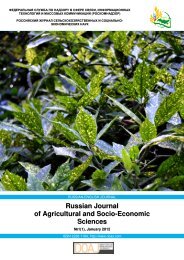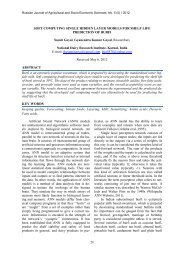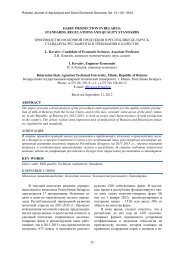Russian Journal of Agricultural and Socio-Economic Sciences ...
Russian Journal of Agricultural and Socio-Economic Sciences ...
Russian Journal of Agricultural and Socio-Economic Sciences ...
Create successful ePaper yourself
Turn your PDF publications into a flip-book with our unique Google optimized e-Paper software.
SULTANA NAYEEM, University <strong>of</strong> Dhakasee a decreasing rate <strong>of</strong> earning until their 11 year<strong>of</strong> stay. In their 12th <strong>and</strong> 13 years they slightlyincreased their slim earnings, but in the end werenot successful at this. They even failed to reachtheir previous rate <strong>of</strong> income (RM 2000), thoughthey had stayed in Malaysia for more than 10years. Or in other words, their length <strong>of</strong> stay didnot assist the strong tied groups to earn more.Though they had stayed more than 10 years, theyhad restricted themselves to their own (ethnical)domain. Limited capabilities <strong>and</strong> information(which in any case they already possessed) failedto show them paths for higher income mobility.On the contrary, regarding weak ties thoughwe notice a lower income rate at the very beginning,it finally helps the migrants to reach theirpeak. Migrants who migrated depending only onweak ties (commercial labour brokers) could notadapt to the foreign environment in the beginning.As they lacked the strong ties, necessary tocope (with foreign customs, language, ways <strong>of</strong>working etc.) with their immigrant life, theyfailed to earn more. But after staying a while theygradually achieved local knowledge on “what todo, where to go” <strong>and</strong> also managed to developnew networks, necessary for upward mobility.These new ties not only provided them with theopportunities for higher income mobility, butalso incorporated risks. Therefore, the decreasingrates <strong>of</strong> income <strong>of</strong> the followers <strong>of</strong> weak ties canbe explained highlighting risks. It is found that inthe host society migrants encounter differenttypes <strong>of</strong> risks ranging from intra-ethnic tension tointer-ethnic conflict. For example, while some <strong>of</strong>the poor migrants identify their weak ties or patronsas exploiters, they also express their fears <strong>of</strong>Tamil Indians. However, to overcome thesedrawbacks they need to find another weak tie (awell-connected person both with the local powerstructure <strong>and</strong> other well-<strong>of</strong>f countrymen). Theytry to find a better one who likewise possessesthe necessary capabilities, links (networks) <strong>and</strong>who is also knowledgeable in combating risks.To find a “risk free” & better strategy they formnew weak ties so they can stay longer in thestudy areas <strong>and</strong> also manage opportunities forhigher income mobility. Though they considerweak ties as commercial <strong>and</strong> exploitative, theystill do not prefer to depend only on their trustworthystrong ties. Their strong ties representtheir own workmates, housemates as well as relatives(who possess more or less same level <strong>of</strong>information <strong>and</strong> networks that they themselvesalready have). Having failed to find a suitable jobat home, they migrate to Malaysia to make theirfortunes (within a short time frame). They alsowant to earn more for a “better future”. Theyknow, if they fail to earn enough money, theywill be unable to maintain their expenditures bothat home <strong>and</strong> abroad. As a result, even thoughthey consider their weak ties exploitative theydepend on them unless better ones are found.Through criticizing them they feel psychologicalrelief. They also express their expectations towardswell-<strong>of</strong>f countrymen. For example, “He isrich, but very polite! Not like others.” This singlesentence denotes how through discursive practicesmigrants are expressing their experiences <strong>and</strong>expectations towards well-<strong>of</strong>f people. Accordingto Moerman (1988),“In every moment <strong>of</strong> talk, people are experiencing<strong>and</strong> producing their cultures, their roles,their personalities.”However, though weak ties are identified asexploitative, the line graph nevertheless showsthat respondents with weak ties have higher incomemobility than those with strong ties. At thesame time, it also demonstrates that the Bangladeshimigrants <strong>of</strong> the study areas do not restrictthemselves only to their close social networks;rather they develop distant networks for highersocial mobility. Thus the migrants <strong>of</strong> a certainarea remain connected with other migrants fromdifferent parts <strong>of</strong> the host society. They thus getopportunities to construct interpersonal networksthrough weak ties, because most <strong>of</strong> the less privilegedmigrants visit either ‘Noakhali’ group or‘Barishal’ group for their higher social mobility.Through their transnational business activities,the better-<strong>of</strong>f merchants assist poor migrants sothat they can maintain transnational networkswith their kith <strong>and</strong> kin.Conclusion. Through this study, we havecome to notice a dilemma concerning migrants’perceptions on weak ties <strong>and</strong> their actual behavior.On the one h<strong>and</strong>, most <strong>of</strong> the poor migrantsperceive their intra-ethnic weak ties as exploitative<strong>and</strong> they depend on them for higher incomemobility <strong>and</strong> for long term settlement in the receivingcountry. In fact, their strong tied networksare noticed as poor <strong>and</strong> less connectedwith the macro level authorities. Hence they lackthe necessary power <strong>and</strong> information, requiredfor upward mobility. Therefore, they need to dependon weakly tied networks in order to overcomeeconomic insolvency <strong>and</strong> achieve higher13



